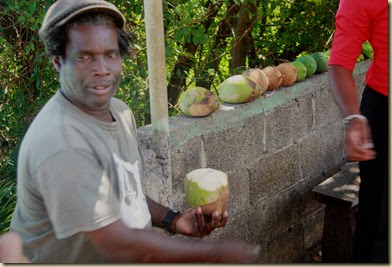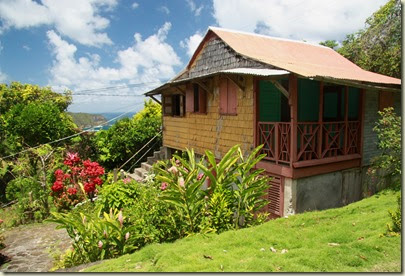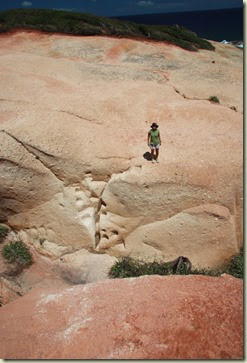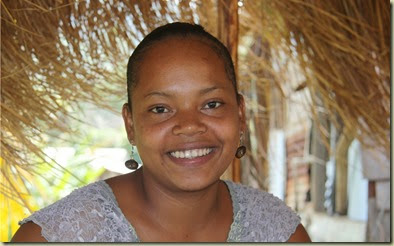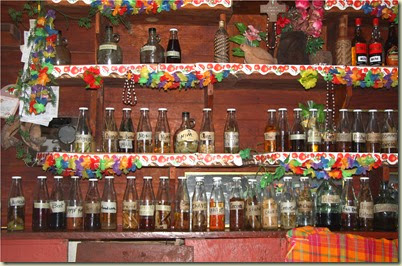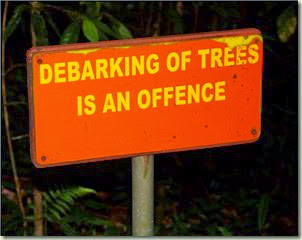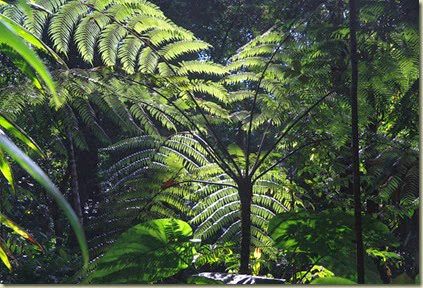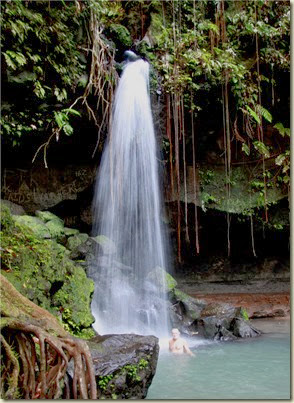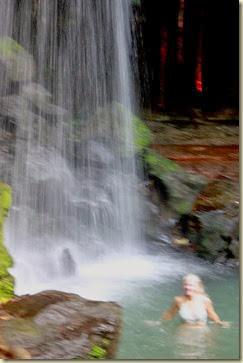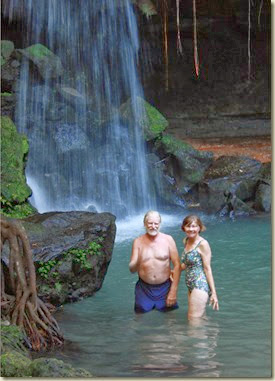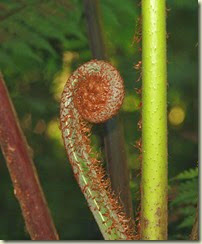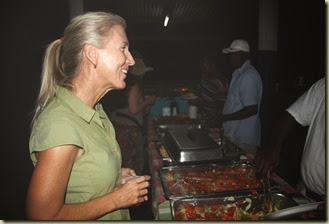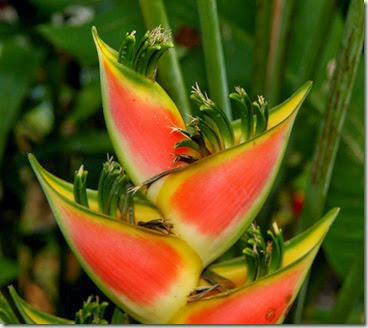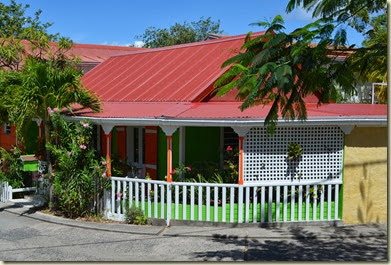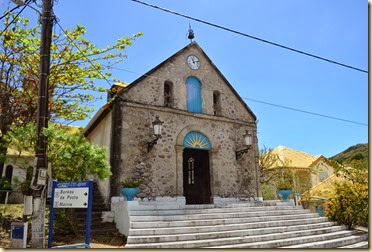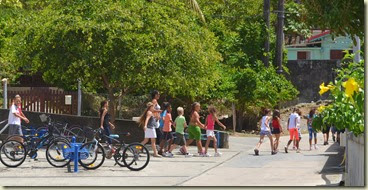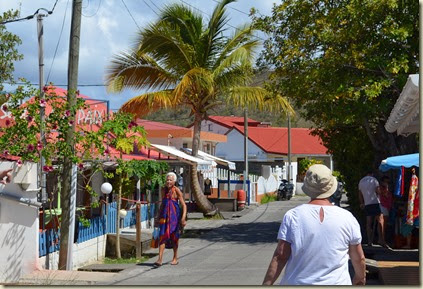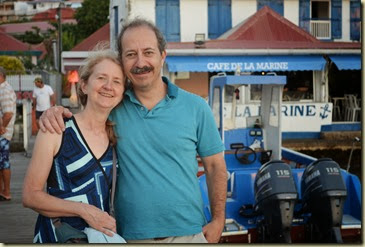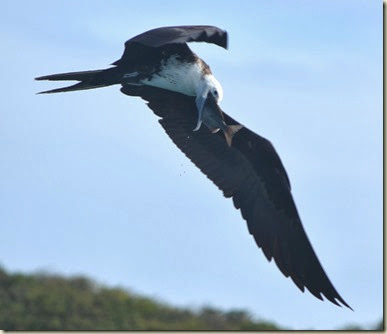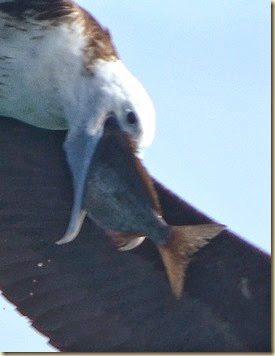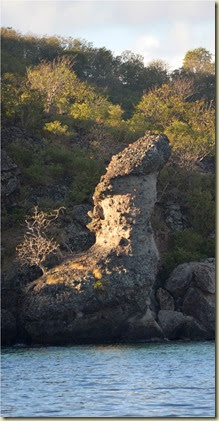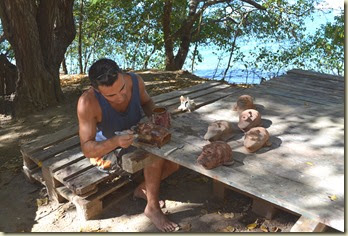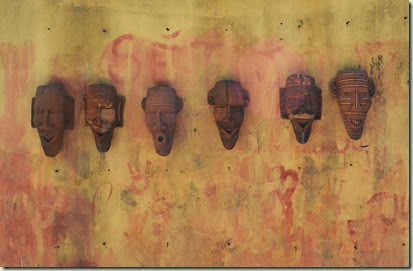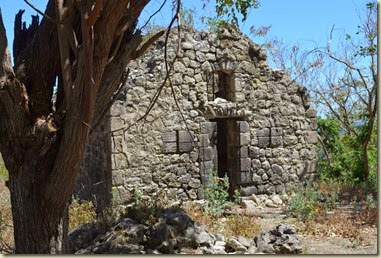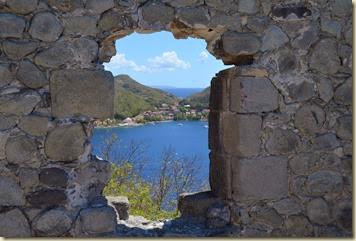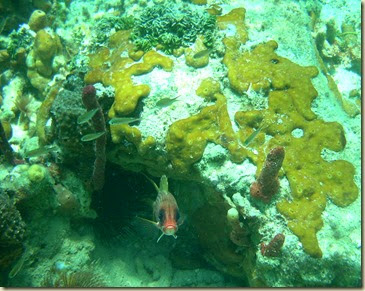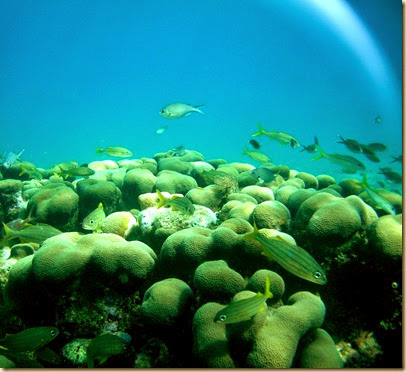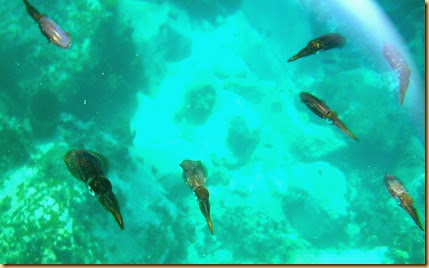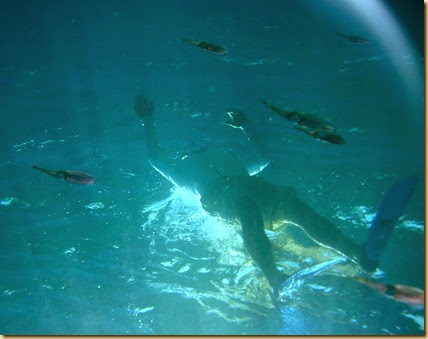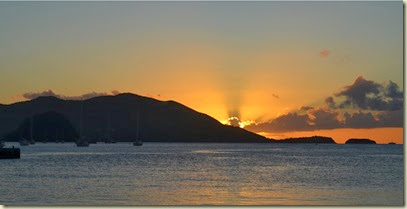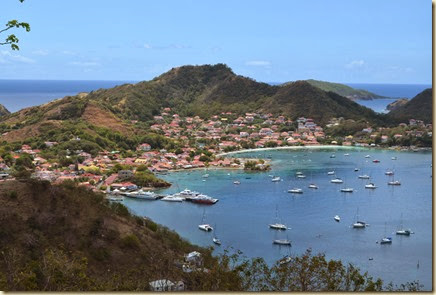
We had a nice tradewind reach down to Guadeloupe from Falmouth, Antigua. We headed into the port at Dashaies (pronounced Dah-Hay for some odd reason) to clear into the French island. The check-in place was closed till 4:00pm, so we decided to up anchor and continue down the coast another 10 miles. The French islands are very kicked-back about checking in, so waiting a few days isn’t an issue. We were on a bit of a schedule to go pickup our brother and sister-in-law, John and Lisa, in Pointe et Pietre. We anchored for the evening in a bay on the mainland side near Pigeon Island. This is the where Jacque Cousteau filmed portions of his 1955 movie “The Silent World” and declared Pigeon Island as one of the 10 best dive sites in the world. That was enough to get us up early and take the dinghy over for a morning snorkel session. Healthy reef, clear waters and a fair number of fish. The best diving we have done so far in the Eastern Caribbean.
After the dive we headed south down the side of Guadeloupe in the lee of the mountains. When we turned at the bottom of Guadeloupe to head toward Pointe et Pietre (PP) we turned straight into the teeth of the tradewinds and had a rambunctious Dacron-assisted-motorboat bash/ride into PP.
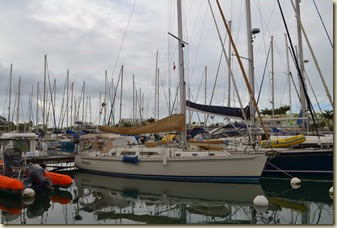
We pulled into the marina in PP to make it easier to pickup John and Lisa. This required a med-moor, where you pickup a mooring ball for the bow and back into a space just wide enough for your boat and fenders to fit, then tie the stern off to the dock. It is stress inducing on the way in and the way out. Like most docking scenarios, if you screw it up there’s 20 people watching and if you nail it, no one’s around.
John and Lisa showed up the next day and we dragged them out to the ‘Casino’, a big shopping market, to do some provisioning. Next morning we left for Iles des Saintes or, in English, The Saints. After about a 4 hour very light wind sail we showed up in the The Saints. A great little set of islands with fresh baguettes, friendly locals, clear diving, interesting history and forts, and women who snorkel topless. What’s not to like?
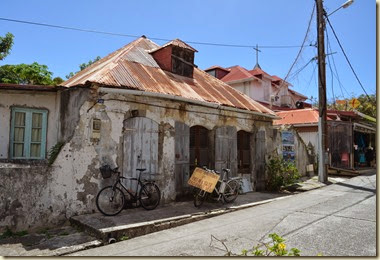
The main town, Le Bourg, is in good shape. Very few cars, almost everyone rides scooters or bikes. The houses are charming. There are a few places like this that add character. (Credit: most of the photos in this blog are John’s.)
The houses all have red roofs.
The local church.
It’s clearly one of the advanced education countries – even the young kids can speak French.
Goat spotting.
Iguana spotting.
People spotting.
Rooster spotting.
John and Lisa spotting… on our way to Lisa’s birthday dinner.
Frigate spotting – check the fish in his mouth
Got it!
We stopped at this ATM on side of the pharmacy to get euro cash. Never could get the thing to deliver money. Turns out it was an off-hours delivery machine for the pharmacy. Duh!
Our onboard forensic, medical geologist said this was syphilitic spire.
We stayed a few days on the small island of Ile Cabrit. It is the location of Fort Josephine, one of the two main fortifications from the British versus French era. Living in one of the dilapidated old buildings was this young French guy who makes pottery masks and welcomed visitors to his island.
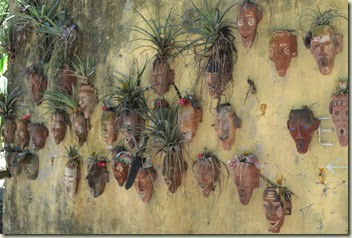
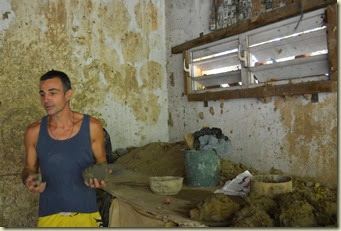
He used local mud and a wood fired kiln. Much of his time was taken up having visiting children make their own masks.
We bought a couple of these at 10 euros each (US$13).
The original Fort Josephine on the top of Ile Cabrit was built in the 1700’s and was paired with Fort Napoleon, over on the main island of Terra de Haute. In its latter years the buildings were used as a prison. During World War II the Vichy government (the side that collaborated with the Nazi’s) imprisoned Gaullists (the side that was with the resistance) here. Prison with a view.
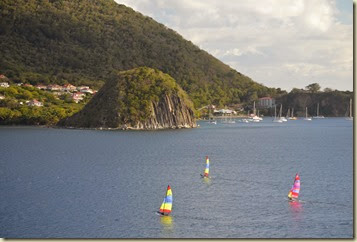
A view of Pain de Surce (sweet bread), another anchorage, from the fort with a few Hobie cats thrown in for color. We had a good snorkel off the point of Pain de Sucre.
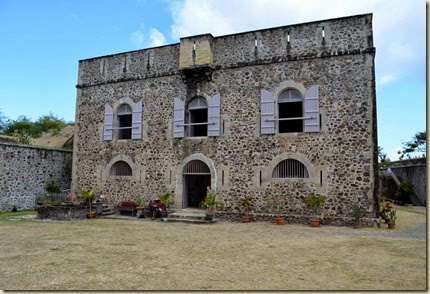
We took the easy way up to the top of the hill to Fort Napoleon – a 3 euro taxi ride. (If you’re going to the fort and museum, it is only open in the morning, closing at noon). The fort was re-built in the mid-1800’s. The French and the English swapped control of the Saints pretty much continuously from the 1600’s to the late 1800’s. The islands were named by Columbus on his second cruise to the Caribbean.
The Battle of the Saints took place in the passage south of the Saints toward Dominica in April 1782. Just after breakfast, 100’s of British and French ships lined up for battle. By dinner time the faster, copper clad, English ships with superior cannons had kicked-ass, giving Britain decisive control of the Caribbean and the Saints. The Saints were handed back to France 20 years later in one of the many great Treaties of European history.
The French really do look at things differently than others. At the Fort museum there are snippets of history. One story describes the French naval officer, Mr. Freminville, arriving in the Saints. He heads off to Sunday church. With a quick side glance he catches the eyes of the cutie Caroline C, a Creole girl. Next day he goes diving for some rare coral and gets slammed unconscious by a rogue wave. Three days latter he wakes up in Caroline’s home, with her tending him at his bedside. A great courtship runs for a few weeks till Mr. F. is called away to fight in St. Kitts. After months go by, Mr. F’s ship passes near the Saints but does not stop, as he was ordered to Martinique. Caroline, thinking he was lost in battle or abandoned her, decides to kill herself in the place that he got slammed by the wave. When Mr. F finally gets back to the Saints he finds Caroline’s house empty and was directed to her grave.
Now this could be a decent love story with a sad but understandable ending if this was a Greek tragedy, or maybe a Romeo and Juliet unrequited love story or even a cheesy American romance novel – but no, this just isn’t the ending for the French. Mr. F returns to Brest as a recluse archeologist and is often seen wearing the dress that Caroline died in. He latter publishes a scientific paper "Essay on the physical and moral influence of the female costume", where he describes that female clothes “have a delicious effect on the nervous system of a delicate being and make it undergo inner delights unknown to those whose organisation is more coarse”. Oo, La, La.
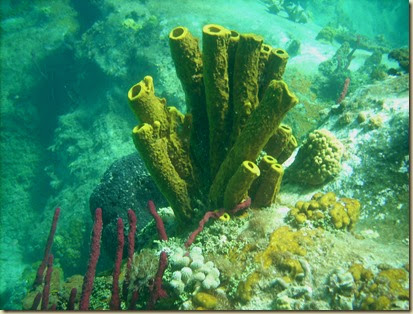
We snorkeled near the mooring field at Ile Cabrit, on the east end of near the Palm trees (good) and at the point at Pain de Sucre (very good). The sponges were doing well, the coral is pretty healthy and there were even fish.
John and Lisa brought down a new Nikon Coolpix L28 for my underwater camera case. Unfortunately it doesn’t fit, by millimeters, as the case was designed for the L24 model. John had an old, original Coolpix sitting around that he also brought down. It fits almost and is usable underwater – hence the UW pics.
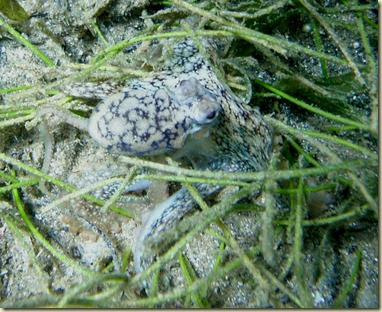
An octopus running away in the Turtle grass.
An ‘if I glue enough leaves on my head no one will see me’ anemone.
Squirrel fish investigating an intruder
The bottom of the Aquarium
Chris’ favorite, the Cuttlefish. These squid like critters hang in large groups a few feet underwater and are very curious about snorkelers.
John being one with the cuttlefish.
It was a fun week having our guests on board. Now we’re back to normal boat life – morning boat maintenance, afternoon snorkeling – with an occasional hunt for a fresh baguette.
Paul
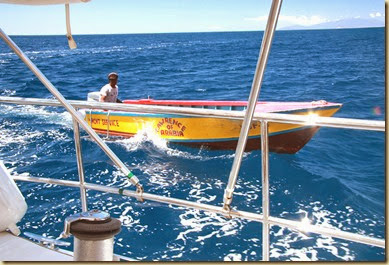
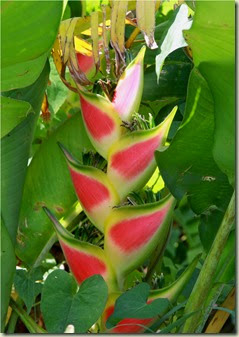 The island is extremely hilly with steep drops off to the ocean. We setup a taxi tour to circumnavigate the north and central part of the island with new friends Jean and Art, on Samana.
The island is extremely hilly with steep drops off to the ocean. We setup a taxi tour to circumnavigate the north and central part of the island with new friends Jean and Art, on Samana. The island has the tallest mountain in the eastern Caribbean. The windy roads cut across the island through small villages where vegetable, fruit and banana plots are all around. The island is one of the poorest in the eastern Carib, but the people are friendly, the island and roads are clean and there’s no obvious poverty. Crime is relatively low here.
The island has the tallest mountain in the eastern Caribbean. The windy roads cut across the island through small villages where vegetable, fruit and banana plots are all around. The island is one of the poorest in the eastern Carib, but the people are friendly, the island and roads are clean and there’s no obvious poverty. Crime is relatively low here. A taxi tour wouldn’t be a third world experience (or is it 2 1/2 world) without the driver stopping to put in a quart of oil.
A taxi tour wouldn’t be a third world experience (or is it 2 1/2 world) without the driver stopping to put in a quart of oil.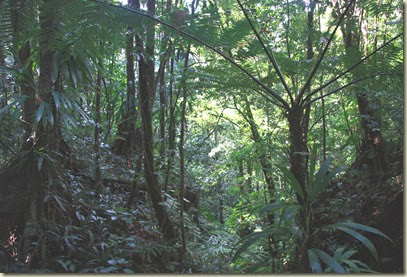 We hiked down to the waterfalls at the Morne Trois Piton (3-peaked mountain) National Park – a World Heritage Site since 1997. The rainforest here is supposed to have 10,000 different species. The trails were densely surrounded by tall tropical hardwoods and giant fern trees.
We hiked down to the waterfalls at the Morne Trois Piton (3-peaked mountain) National Park – a World Heritage Site since 1997. The rainforest here is supposed to have 10,000 different species. The trails were densely surrounded by tall tropical hardwoods and giant fern trees.